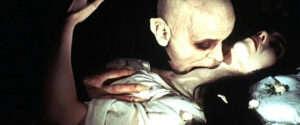Movie Review
Nosferatu: A Symphony of Horrors (1922)
Directed by FW Murnau
Nosferatu the Vampyre (1979)
Directed by Werner Herzog
Nosferatu (2024)
Directed by Robert Eggers
(WARNING: story and plot twists discussed in explicit and gory detail)
FW MURNAU did a low-budget unauthorized adaptation of Bram Stoker’s Dracula titled Nosferatu (1922) which Stoker’s widow pursued with a vengeance, demanding all prints and negatives be destroyed (despite which copies eluded her grasp, and the film went on to achieve an unholy immortality); Werner Herzog did a remake in 1979 employing 10,000 rats and his own inimitable filmmaking style; now Robert Eggers — who professes admiration for the Murnau — has crafted his own version, shifting emphasis from vampire to victim in his 2024 remake.
And how does Eggers’ compare? Well, let me tell you.
1922Murnau took his constraints — an unauthorized production, a small budget — and fashioned a style out of it: writer Henrik Galeen switched out all the names (Count Orlok, played by Max Schreck, for Count Dracula, Thomas Hutter for Jonathon Harker, Ellen for Harker’s wife Mina), streamlined the narrative (no chase across Europe; most of the side characters either combined or reduced or eliminated), and has the creature perish at dawn — the first but certainly not the last time this method was used onscreen. Wouldn’t be surprised if Murnau thought of it; death by sunlight is something I imagine a filmmaker might dream up, if not actually fantasize about.
Instead of the stylized Expressionist sets of The Cabinet of Dr. Caligari, Murnau chose to shoot on location, and it’s his use of locations that is the source of much of the film’s power. The High Tatras (understudying for the Carpathians) look like a vast hard-muscled back forcing its way up out of the surrounding soil, a violent upheaval freeze-framed for our appreciation. The castle is an Escher fantasy of shadow and stone, with sudden plunges to isolate the unwary guest, and deep passageways to allow late-night snacking. The sea is a shimmering sheet over which the tall-masted Empusa glides, carrying its doomed cargo; the Count’s residence opposite the Hutters’ (actually the Salzspeicher in Lubeck) resembles a cave wall pockmarked with rat holes; you expect to see eyes glittering out of each dark cavity.
Murnau’s miserable creature — designed by artist and occultist Albin Grau — is gaunt and cadaverous, with a head like a shaven rodent’s skull, tiny LED lights for eyes, a pair of huge front fangs. With the simplest effects Murnau reminds us of Orlok’s abilities and strength — fast-forward motion denoting inhuman speed; great earth-filled coffins lifted like so much luggage; Orlok himself pivoting straight out of his casket, the ultimate popup surprise for the ultimate children’s nightmare of a book.
Murnau’s stripped-down retooling of Stoker’s tale is revealed to be a menage a trois between a man, a woman, and a parasite, in a world being drained of its population by plague (the film came out only two years after the Spanish Flu killed anywhere from 50 to 100 million people, one of the deadliest pandemics in history) — said parasite not just cause and carrier but the walking incarnation of the plague. Murnau could not be more direct: the world is a frightening place he tells us, and is out for our blood.
1979And then there’s Werner Herzog, who considers the Murnau Nosferatu the most important of German films and still feels the need to put out his own version. Herzog’s picture is more intimate, his filmmaking more handheld casual; even the shots of mountain ranges suggest more a passerby stealing glances during a hike than a serious observer determined to contemplate their majesty and scale. Notably the ship’s passage is truncated (where in the original it was a dramatic high point), and the Count’s new-bought residence seems like a rattier, more dilapidated version of the first.
But Herzog’s camerawork — accompanied by West German group Popol Vuh’s hypnotic drone — holds a power all its own, the mobile camera capturing on the fly the twisted faces of Mexican mummies, the plunge of water down a narrow gorge, the leisurely flutter of a bat in flight (actually borrowed from a documentary — but presented just so, with slowed motion and softspoken music and intense blue background — that said stock gives the film a darkly emblematic image to haunt one’s dreams with).
Klaus Kinski’s Count Dracula (with the rights entering public domain, Herzog decided to use the original’s names) owes his basic features to Max Schreck’s Count Orlok, but his eyes are lonelier, his lips more sensuous, his voice wheezy and gratingly high – he’s like the stereotype of an unhappy child, shunned by others for his asthma attacks, who grows up to prey on children. Bruno Ganz, who plays Jonathon Harker, is a virile man able to run energetically up and down stairs and slam his shoulder against the odd barred castle door, yet when Kinski’s Dracula approaches you immediately fear for the former’s life; Ganz’s Harker may look like a formidable physical specimen but Kinski’s vampire is ancient insatiable hunger.
Matching Kinski stare for stare is Isabelle Adjani’s Lucy Harker (for unknown reasons she and Mina have switched names and roles) with dark eyes that admit to little calculation and even less sanity. Kinski’s Dracula is evil, Lucy intensely, even terrifyingly, passionate — angel or devil, her eyes warn you, if you ever get in her way you will be thoroughly fucked.
2024Arguably Egger’s bravest, most breathtaking achievement is to position himself in direct comparison with the two filmmakers. I’ve liked some of Egger’s work — arguably my favorite to date is his two-hander masterpiece of increasingly sodden misery The Lighthouse — but against Murnau’s elemental sense of beauty and Herzog’s perverse mysticism Eggers sadly comes up short. The digitally enhanced landscapes and digitally enhanced weather have little of the weight or presence of Murnau’s Carpathians or North Atlantic; his citizenry line up their coffins and discuss feeling loss and despair but can’t approximate the awful resignation of Murnau’s, who wordlessly accept Orlok’s gift of death (Herzog took his townfolk’s response a step further, having them celebrate with music and dance, even an elaborate dinner).
Actually, acceptance was only the final stage of a process Murnau inflicts on the people of Wisborg; along the way they panic and pin blame on the most convenient scapegoat among them, poor demented Knock, who flees and hides (in a moment of unsettling mob fury, a scarecrow is pulled down and torn apart in his stead).
It isn’t just digital effects that bar Eggers from realizing his predecessors’ cleareyed vision; what made Herzog’s version work, I suspect, was that he shared with Murnau a maverick’s willingness to strike out anyway and make do with what he’s got, only he did it his way, in the style of a veteran documentary filmmaker. A small budget? Go location shooting. Footage of flapping bats? Borrow from a documentary. Vampire’s death? Cut Kinski loose; he’ll perform a death scene that will make you forget all other death scenes, digitally enhanced or not.
Bill Skarsgard’s Orlok is this version’s profoundest mystery, but when finally unveiled he’s basically a half-rotten corpse with a handlebar ’stache. I’m aware of the controversies about facial hair, and in fact Stoker does describe Dracula as sporting a pair, but the ’stache on Skarsgard (as opposed to Schreck’s and Kinski’s verminous design) softens his ghoulish visage, makes him less threatening than endearing, less like a Transylvanian monster than Frank Zappa.
And oh, the bit about Skarsgard “deepening his voice”! Such a predictable way to intimidate; is why I much prefer Kinski’s gambit — his high wheezy tone, like long fingernails dragged across a chalkboard, is in the end more frightening, especially when you realize (as with Peter Lorre in Fritz Lang’s M) that it’s less the voice of a sexual predator than a sexual carnivore, one who sees all men — and women, and children — as his prey.
As for Lily-Rose Depp — respect her dedication and salute her and Eggers’ determination to focus less on the victimizer and more on the victim, but for all the blood and sweat and tears shed, all the acrobatics and eye-rolling and shrieking she undergoes (at one point I felt my shoulder blades pop in sympathy), she doesn’t quite achieve the impact of Isabelle Adjani with both eyes wide open. Depp has all the intensity of a young up-and-comer with something to prove; Adjani has the serenity of someone who is and has always been this side of unhinged. In this, in The Story of Adele H., and in Possession — perhaps her most out-there role – she’s the perfect match for the equally freakshow Kinski; between the two of them everyone and everything within range and recent memory just fade like shadows into the surrounding mist.
Nosferatu will be opening in Philippine theaters on Feb. 25.

